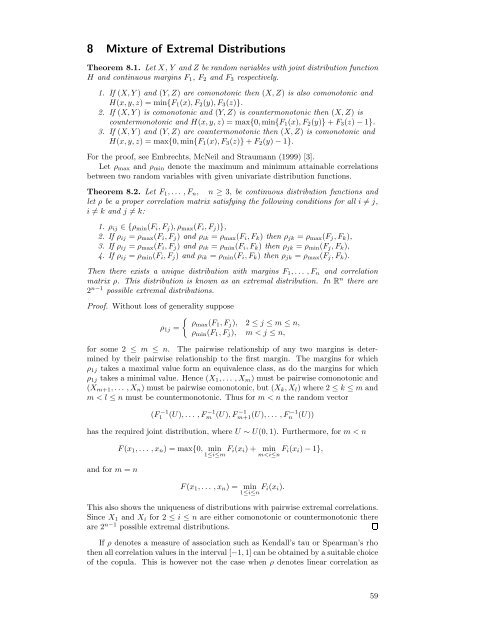Modelling Dependence with Copulas - IFOR
Modelling Dependence with Copulas - IFOR
Modelling Dependence with Copulas - IFOR
Create successful ePaper yourself
Turn your PDF publications into a flip-book with our unique Google optimized e-Paper software.
8 Mixture of Extremal Distributions<br />
Theorem 8.1. Let X, Y and Z be random variables <strong>with</strong> joint distribution function<br />
H and continuous margins F 1 , F 2 and F 3 respectively.<br />
1. If (X, Y ) and (Y,Z) are comonotonic then (X, Z) is also comonotonic and<br />
H(x, y, z) =min{F 1 (x),F 2 (y),F 3 (z)}.<br />
2. If (X, Y ) is comonotonic and (Y,Z) is countermonotonic then (X, Z) is<br />
countermonotonic and H(x, y, z) =max{0, min{F 1 (x),F 2 (y)} + F 3 (z) − 1}.<br />
3. If (X, Y ) and (Y,Z) are countermonotonic then (X, Z) is comonotonic and<br />
H(x, y, z) =max{0, min{F 1 (x),F 3 (z)} + F 2 (y) − 1}.<br />
For the proof, see Embrechts, McNeil and Straumann (1999) [3].<br />
Let ρ max and ρ min denote the maximum and minimum attainable correlations<br />
between two random variables <strong>with</strong> given univariate distribution functions.<br />
Theorem 8.2. Let F 1 ,... ,F n , n ≥ 3, be continuous distribution functions and<br />
let ρ be a proper correlation matrix satisfying the following conditions for all i ≠ j,<br />
i ≠ k and j ≠ k:<br />
1. ρ ij ∈{ρ min (F i ,F j ),ρ max (F i ,F j )},<br />
2. If ρ ij = ρ max (F i ,F j ) and ρ ik = ρ max (F i ,F k ) then ρ jk = ρ max (F j ,F k ),<br />
3. If ρ ij = ρ max (F i ,F j ) and ρ ik = ρ min (F i ,F k ) then ρ jk = ρ min (F j ,F k ),<br />
4. If ρ ij = ρ min (F i ,F j ) and ρ ik = ρ min (F i ,F k ) then ρ jk = ρ max (F j ,F k ).<br />
Then there exists a unique distribution <strong>with</strong> margins F 1 ,... ,F n and correlation<br />
matrix ρ. This distribution is known as an extremal distribution. In R n there are<br />
2 n−1 possible extremal distributions.<br />
Proof. Without loss of generality suppose<br />
{<br />
ρmax (F<br />
ρ 1j =<br />
1 ,F j ), 2 ≤ j ≤ m ≤ n,<br />
ρ min (F 1 ,F j ), m < j ≤ n,<br />
for some 2 ≤ m ≤ n. The pairwise relationship of any two margins is determined<br />
by their pairwise relationship to the first margin. The margins for which<br />
ρ 1j takes a maximal value form an equivalence class, as do the margins for which<br />
ρ 1j takes a minimal value. Hence (X 1 ,... ,X m ) must be pairwise comonotonic and<br />
(X m+1 ,... ,X n ) must be pairwise comonotonic, but (X k ,X l )where2≤ k ≤ m and<br />
m
















